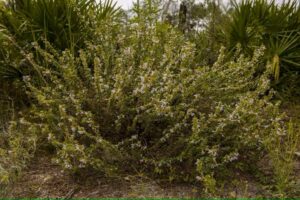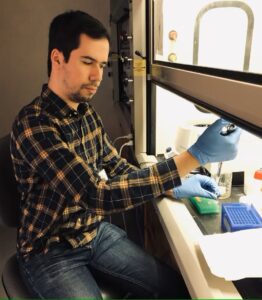By Andre A. Naranjo, Florida International University
Modern scrub mints, delicate flowering plants that grow mostly in Florida, likely result from ancient hybridization, according to a recent study I published with colleagues.
Scrub mints are a clade – a group of organisms that share a common ancestor. They grow exclusively on the North American coastal plain. Many species in this clade are endangered and confined to unique habitats, such as sandhills and scrub.
Other well-known examples of clades include primates, orchids, daisies and insects.
Hybridization occurs when two species interbreed and produce new offspring with genes and traits from both species. Our study suggests that scrub mints hybridized during a geological period known as the Pleistocene, which lasted from about 11,700 to 2.58 million years ago. The Pleistocene was characterized by dramatic changes in climate, including a series of ice ages.
One significant finding from our work is that a group of scrub mints called calamints that taxonomists classified as part of the genus Clinopodium as early as 1899 are actually genetically distinct from other plants in this genus.
These types of misclassifications create confusion around species’ identities, delaying conservation actions and leaving many rare plants without legal protections.

(Kristen Grace/Florida Museum, CC BY)
Our work suggests that calamints may consist of several separate species that need new scientific names. This includes plants known commonly as the scarlet calamint, Georgia calamint and Ashe’s calamint. All of these currently lack endangered status.
Additionally, we discovered that annual scrub mints in the genus Dicerandra – found as far north as South Carolina – originated from back-to-back hybridization events with their perennial relatives. Annual plants last only one growing season, while perennials can persist for multiple years. This ancient crossbreeding suggests that hybridization is a common mechanism of diversification in these rare plants.
We also found that the Titusville balm, currently classified as a recent hybrid, has actually been evolving for hundreds of thousands of years.
Reclassifying a plant takes time and effort. It involves detailed genetic and morphological analysis to confirm the plant’s distinctiveness, followed by a formal scientific description and publication. However, following these steps would allow these plants to be recognized under conservation laws.
Why it matters
Our results could affect the future of these rare plants.
The potential extinction of one of Florida’s ancient plant species is more than just the loss of an individual species; it’s the loss of millions of years of evolution. These plants have thrived in Florida’s ecosystems through gradual adaptations over millennia, and their disappearance would leave lasting gaps in the region’s evolutionary history.
The collapse of these plant species also threatens the broader ecosystem, including wildlife such as scrub jays and insects such as bee flies that rely on them for food and shelter.
And our findings have broader implications for how species are classified and protected under conservation laws. Of the 24 species of scrub mints known today, over half are listed as threatened or endangered at either the state or federal level.
However, plants that hybridized recently are not considered true species under the Endangered Species Act. This means hybrids often lack legal protections, even if they occur in habitats that are rapidly disappearing due to human development. Plants that resulted from ancient hybridization are considered true species and can be protected.
How we did our work

In our study, published in Molecular Phylogenetics and Evolution, we used genetic sequencing to analyze 238 different genes to map the complex relationships among these species. We then compared DNA patterns with trace evolutionary relationships using a dataset of all available DNA sequences.
This allowed us to identify distinct lineages, showing that certain groups, such as perennial Dicerandra, were likely individual species. It is more difficult to define these relationships by looking at individual genes.
We chose this group because we wanted to better understand relationships between species in a clade made up almost entirely of threatened and imperiled plants found entirely within a biodiversity hot spot.
What still isn’t known
While our study clarified many relationships within the scrub mint clade, several questions remain.
Plants typically have tens of thousands of genes. Each gene tells a different evolutionary story. Some genes might show two species as sisters to each other, while another gene with a different evolutionary path might show a different set of relationships.
This wealth of discordant data means some evolutionary connections remain unclear, especially within perennial Dicerandra.
Additionally, the full extent of hybridization events – particularly between perennial species – needs further investigation.
Another area requiring more research is the possibility of hidden diversity within the calamints – meaning there may be species that look similar to one another but are actually distinct. Studying these “hidden” species could reveal new insights into the group’s diversity.
While the current outlook for the scrub mints is grim, researchers are still unsure whether small pockets could survive in microhabitats or be rescued through targeted conservation efforts.
The Research Brief is a short take on interesting academic work.![]() Andre A. Naranjo is botanical curator at Florida International University.
Andre A. Naranjo is botanical curator at Florida International University.
This article is republished from The Conversation under a Creative Commons license. Read the original article. Banner photo: Scrub mints are critical for pollinators, including the rare blue calamintha bee (Osmia calaminthae) (Kristen Grace/Florida Museum, CC BY).
Sign up for The Invading Sea newsletter by visiting here. To support The Invading Sea, click here to make a donation. If you are interested in submitting an opinion piece to The Invading Sea, email Editor Nathan Crabbe at ncrabbe@fau.edu.



